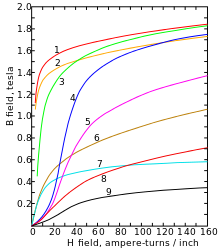Saturation (magnetic)

Seen in some magnetic materials, saturation is the state reached when an increase in applied external magnetizing field H cannot increase the magnetization of the material further, so the total magnetic field B levels off. It is a characteristic particularly of ferromagnetic materials, such as iron, nickel, cobalt and their alloys.
Introduction
Saturation is most clearly seen in the magnetization curve (also called BH curve or hysteresis curve) of a substance, as a bending to the right of the curve (see graph at right). As the H field increases, the B field approaches a maximum value asymptotically, the saturation level for the substance. Technically, above saturation, the B field continues increasing, but at the paramagnetic rate, which is 3 orders of magnitude smaller than the ferromagnetic rate seen below saturation.[2]
The relation between the magnetizing field H and the magnetic field B can also be expressed as the magnetic permeability: or the relative permeability , where is the vacuum permeability. The permeability of ferromagnetic materials is not constant, but depends on H. In saturable materials the relative permeability increases with H to a maximum, then as it approaches saturation inverts and decreases toward one.[2][3]
Different materials have different saturation levels. For example, high permeability iron alloys used in transformers reach magnetic saturation at 1.6 - 2.2 teslas (T),[4] whereas ferrites saturate at 0.2 - 0.5 T.[5] Some amorphous alloys saturate at 1.2-1.3 T.[6]

Explanation
Ferromagnetic materials like iron that show saturation are composed of microscopic regions called magnetic domains that act like tiny permanent magnets. Before an external magnetic field is applied to the material, the domains are oriented in random directions. Their tiny magnetic fields point in random directions and cancel each other out, so the material has no overall net magnetic field. When an external magnetizing field H is applied to the material, it penetrates the material and aligns the domains, causing their tiny magnetic fields to turn and align parallel to the external field, adding together to create a large magnetic field which extends out from the material. This is called magnetization. The stronger the external magnetic field, the more the domains align. Saturation occurs when practically all the domains are lined up, so further increases in applied field can't cause further alignment of the domains.
Effects and uses
Saturation limits the maximum magnetic fields achievable in ferromagnetic-core electromagnets and transformers to around 2 T, which puts a limit on the minimum size of their cores. This is one reason why high power utility transformers are so large.
In electronic circuits, transformers and inductors with ferromagnetic cores operate nonlinearly when the current through them is large enough to drive their core materials into saturation. This means that their inductance and other properties vary with changes in drive current. In linear circuits this is usually considered an unwanted departure from ideal behavior. When AC signals are applied, this nonlinearity can cause the generation of harmonics and intermodulation distortion. To prevent this, the level of signals applied to iron core inductors must be limited so they don't saturate. To lower its effects, an air gap is created in some kinds of transformer cores.[7]
On the other hand, saturation is exploited in some electronic devices. Saturation is employed to limit current in saturable-core transformers, used in arc welding. When the primary current exceeds a certain value, the core is pushed into its saturation region, limiting further increases in secondary current. In a more sophisticated application, saturable core inductors and magnetic amplifiers use a DC current through a separate winding to control an inductor's impedance. Varying the current in the control winding moves the operating point up and down in the saturation curve, controlling the AC current through the inductor. These are used in variable fluorescent light ballasts, and power control systems.[8]
See also
Notes
- ^ Steinmetz 1917, fig.42
- ^ a b Bozorth 1993
- ^ Bakshi 2003, p.3-31
- ^ Laughton & Warne 2003, chpt. 8
- ^ Chikazumi 1997, table 9.2
- ^ Hamakawa et al. 1992
- ^ Elliott 2010
- ^ Choudhury 2005, Section 2.9.1
References
- Bozorth, Richard M. (1993) [Reissue of 1951 publication]. Ferromagnetism. AN IEEE Press Classic Reissue. Wiley-IEEE Press. ISBN 0-7803-1032-2.
- Chikazumi, Sōshin (1997). Physics of Ferromagnetism. Clarendon Press. ISBN 0-19-851776-9.
- Choudhury, D. Roy (2005). Modern Control Engineering. Prentice-Hall of India. ISBN 81-203-2196-0.
{{cite book}}: Unknown parameter|address=ignored (|location=suggested) (help) - Rod, Elliott (2010). "Transformers - The Basics (Section 2)". Beginner's Guide to Transformers. Elliott Sound Products. Retrieved 03-17-11.
{{cite web}}: Check date values in:|accessdate=(help); Unknown parameter|month=ignored (help) - USA 5126907, Yoshihiro Hamakawa, Hisashi Takano, Naoki Koyama, Eijin Moriwaki, Shinobu Sasaki, Kazuo Shiiki, "Thin film magnetic head having at least one magnetic core member made at least partly of a material having a high saturation magnetic flux density", issued 1992
- Laughton, M. A.; Warne, D. F., eds. (2003). Electrical Engineer's Reference Book (Sixteenth ed.). Newnes. ISBN 0-7506-46373.
- Steinmetz, Charles (1917). Theory and Calculation of Electric Circuits. McGraw-Hill.
- Bakshi, V.U. (2009). Basic Electrical Engineering. Technical Publications. p. 3.31. ISBN 8184313349.
{{cite book}}: Unknown parameter|coauthors=ignored (|author=suggested) (help)



